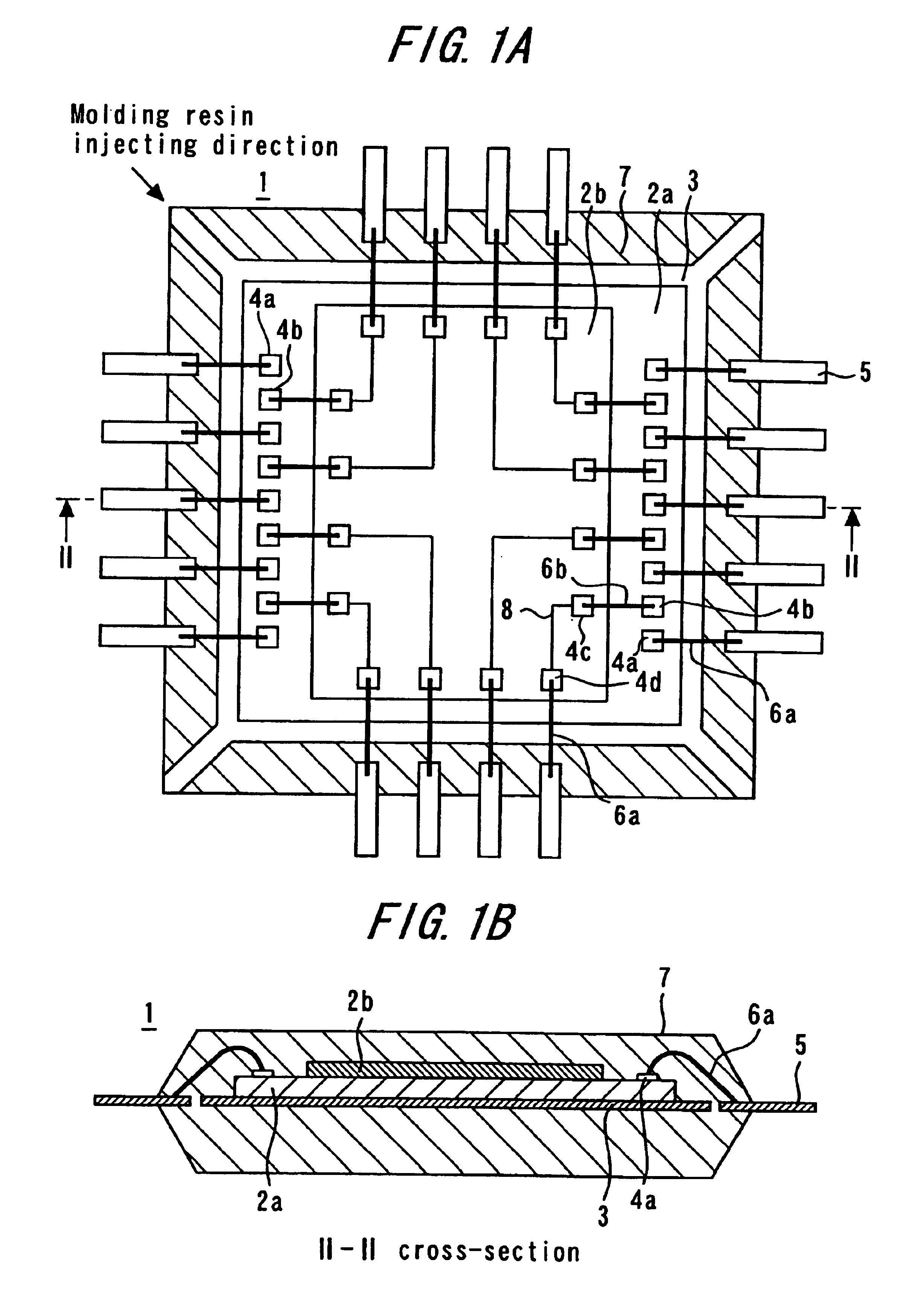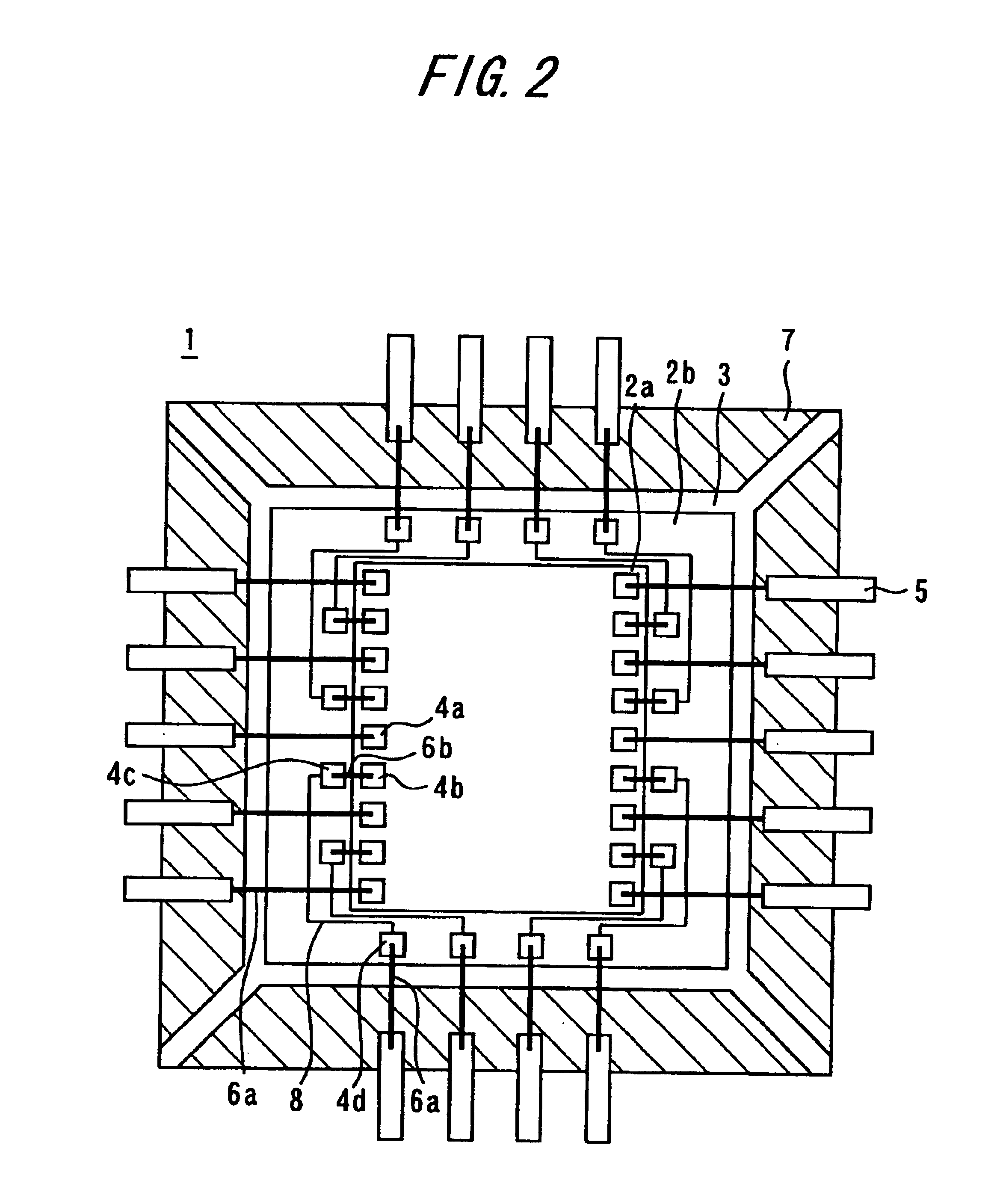Semiconductor device with stacked semiconductor elements
a semiconductor element and semiconductor technology, applied in the field of semiconductor devices, can solve problems such as the increase of demand
- Summary
- Abstract
- Description
- Claims
- Application Information
AI Technical Summary
Problems solved by technology
Method used
Image
Examples
first embodiment
FIG. 1A is a plan showing a semiconductor device according to a First Embodiment of the present invention whose upper portion of a molding resin is cut away; and FIG. 1B is a cross-section thereof along a chain line II—II. In the drawings, reference numeral 1 denotes a semiconductor device. A first semiconductor element 2a has a plurality of first pads 4a and a plurality of second pads 4b arrayed along the two facing sides of the major surface. A second semiconductor element 2b has a plurality of third pads 4c and a plurality of fourth pads 4d. The plurality of third pads 4c are arrayed along sides where the first pads 4a and the second pads 4b are arrayed. The plurality of fourth pads 4d are arrayed along sides where the first pads 4a and the second pads 4b are not arrayed. Aluminum wirings 8 are first wirings for electrically connecting the plurality of third pads 4c to the plurality of fourth pads 4d on the major surface. The aluminum wirings 8 are formed in an interlayer film (n...
second embodiment
FIG. 2 is a perspective plan showing a semiconductor device according to a Second Embodiment of the present invention whose upper portion of the molding resin is cut away. The parts same as or corresponding to the parts in FIG. 1 are denoted by the same reference numerals, and the description thereof will be omitted. The semiconductor device 1 of the First Embodiment has a second semiconductor element 2b stacked on a first semiconductor element 2a, while the semiconductor device 1 of the Second Embodiment has a first semiconductor element 2a stacked on a second semiconductor element 2b. By adopting this structure, the connection of the pads 4b of the first semiconductor element 2a to the inner leads 5 can be realized through the second semiconductor element 2b even if the second semiconductor element 2b has a larger area than that of the first semiconductor element 2a.
third embodiment
FIG. 3 is a perspective plan showing a semiconductor device according to a Third Embodiment of the present invention whose upper portion of the molding resin is cut away. The parts same as or corresponding to the parts in FIG. 1 are denoted by the same reference numerals, and the description thereof will be omitted. The semiconductor device 1 of the Third Embodiment has two rows of pads 4a and pads 4b on each of two facing sides of a semiconductor element 2a. By adopting this structure, a larger number of pads 4a and pads 4b can be provided on a semiconductor element without damaging easiness of probing in wafer test. Furthermore, three or more rows of pads 4a and pads 4b may be disposed on each side, and thereby, the number of pads that can be disposed can be increased.
PUM
 Login to View More
Login to View More Abstract
Description
Claims
Application Information
 Login to View More
Login to View More - R&D Engineer
- R&D Manager
- IP Professional
- Industry Leading Data Capabilities
- Powerful AI technology
- Patent DNA Extraction
Browse by: Latest US Patents, China's latest patents, Technical Efficacy Thesaurus, Application Domain, Technology Topic, Popular Technical Reports.
© 2024 PatSnap. All rights reserved.Legal|Privacy policy|Modern Slavery Act Transparency Statement|Sitemap|About US| Contact US: help@patsnap.com










